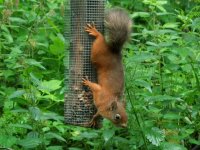Alan Hobson said:
Hi All,
Breffni's contribution was interesting and helpful for Ireland, but it is time to gently correct the inaccuracy re mainland UK. Red squirrels did decline here circa 1700, especially (ironically) in areas they now hold out in (Scotland and Northumberland). However, they didn't die out entirely. That is why there is genetically a British strain in Cumbria quite distinct from a continental strain there (Martin, I think this is what you were referring to, although I had already found it out from my own research last year).
So, Beany, you are quite right to query the "extinct 1700" claim.
Thanks - i'll gently restate my comment:
For Ireland there is no evidence of red squirrels in ireland prior to 1815 when there was a well documented introduction.
For Britain, red squirrel populations were reduced to small pockets in the south of england up to ca 1700 - thereafter there were large scale introductions from continental stock. The red squirrel population in Britain today is derived from continental stock in the vast majority.
That said a small population in Cumbria is genetically distinct from the main British population (does this mean that it is a pure vestige of the origional English stock? Nobody knows as yet).
I could list 20 or so scholarly papers but the most authorative account is given by Oliver Reckham in numerous pubs, notably The English Countryside pg 51 (2000).
Lurz et al and Barrattt et al have done a lot of work on genetic diversity of reds - below are two abstracts (the papers are copyright protected) - i'll leave it to yourself to judge:
*****
Patterns of genetic diversity in the red squirrel (Sciurus vulgaris L.): Footprints of biogeographic history and artificial introductions
Authors: Hale M.L.1; Lurz P.W.W.2; Wolff K.2
Source: Conservation Genetics, Volume 5, Number 2, 2004, pp. 167-179(13)
Abstract:
British S. vulgaris are classified as a separate subspecies, S. v. leucourus, to mainland Europe. While S. vulgaris is not under threat across most of its Eurasian range, in Britain, Ireland and Italy populations are declining, mainly due to the introduction of the American grey squirrel (S. carolinensis). In this study, we conducted an extensive survey of mitochondrial DNA variation in British S. vulgaris populations and a preliminary survey of continental European populations. Our main aims were to determine the extent to which any populations of S. vulgaris in Britain are partially or wholly the product of artificial translocation of red squirrels from continental Europe, and whether continental population variation will provide information on post-glacial reafforestation patterns in Europe. We found that the majority of extant populations of British S. vulgaris are of continental ancestry, many with a very recent (last 40 years) Scandinavian ancestry. The Scandinavian haplotype has rapidly become the most dominant in northeastern Britain, despite not appearing in northern English populations until 1966. This suggests that these squirrels may have an adaptive advantage in the non-native spruce dominated conifer plantations of northern England. Our preliminary examination of continental populations demonstrated that they are sufficiently differentiated to allow a phylogeographic study of this species.
******
Genetic structure of fragmented populations of red squirrel (Sciurus vulgaris) in the UK.
Barratt EM, Gurnell J, Malarky G, Deaville R, Bruford MW.
Institute of Zoology, Regents Park, London, UK.
The relationships among 207 squirrels from 12 locations in the UK and three in mainland Europe were examined using mitochondrial DNA (mtDNA) control region sequence. Twenty-six haplotypes were detected, many of which were population specific. Eighty per cent of the populations analysed contained two or more haplotypes. Hierarchical analysis of molecular variance showed the majority of genetic variation to be partitioned among populations. Genetic diversity varied considerably within the UK, and conformed to no obvious geographical trend. The populations in Argyll and Spadeadam Forest showed the highest levels of variation in the UK. However, the greatest genetic diversity was seen in Bavaria, southern Germany where six unique alleles were detected in a sample of 10 individuals. Phylogenetic analysis revealed no evolutionary divergence between UK and mainland European haplotypes. We conclude that, within the UK, the genetic patterns observed are most likely to be explained by the effects of genetic drift which has occurred since the isolation of populations during the past few hundred years, hence we cannot detect any underlying phylogeographic pattern. Therefore, the use of larger, geographically distinct populations within the UK for augmentation of small isolated populations is unlikely to pose problems of genetic incompatibility. Further, the role that demographic factors may have in complicating the application of current genetically based management unit criteria is likely to need further attention.
PMID: 10703551 [PubMed - indexed for MEDLINE]







